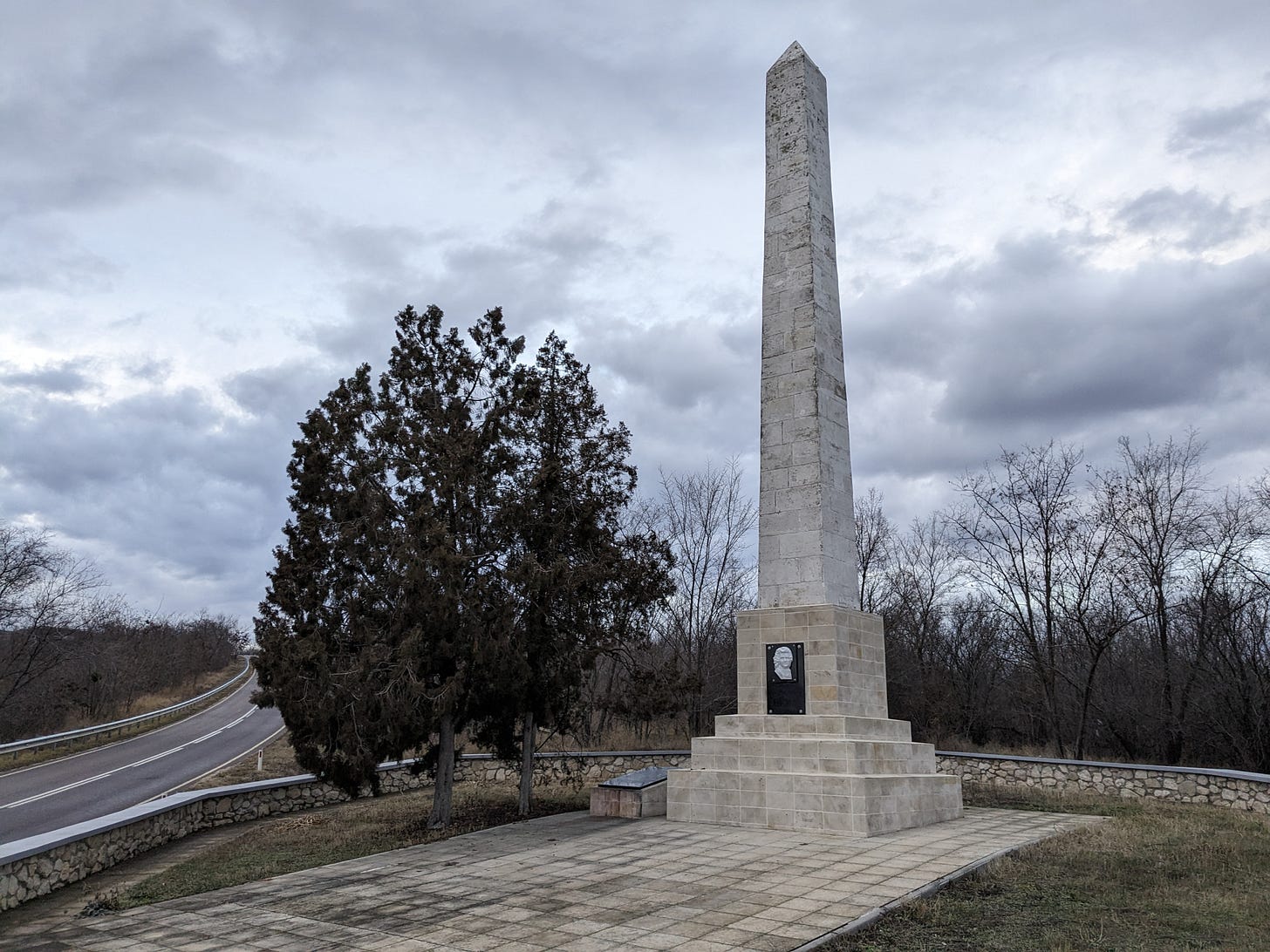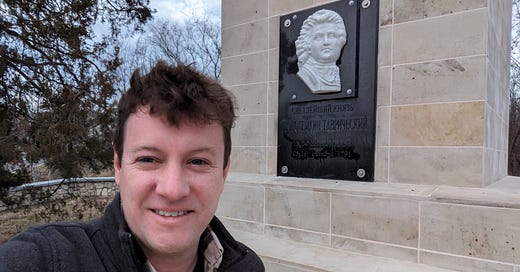The Death in a Moldovan Field That Putin and Russia Won't Forget
September 18, 2024
Modernly remembered mostly for creating fake villages, Grigory Potemkin´s name and legacy are reemerging in the context of war and a new Russian imperial project.
On October 16th 1791 Russian Prince Gregory Potemkin died in a lonely field in modern day Moldova. The Prince had fallen ill while on his last great campaign of Russian Imperial Expansion and was trying to travel from Iasi to the city of Mykolaiv in modern day Ukraine, a city he founded. According to historian and Potemkin biographer Simon Sebag Montefiore, the great prince died surrounded by his traveling court of Russian nobles, Ukrainian Cossacks, Moldovan Boyars and even a few passing peasants. This traveling court was notable both in its size, accounting for around 5 carriage loads of notables as well as soldiers and servants, but also its diversity. In addition to a Russian Countess and many nobles from around the empire, the Prince traveled with Orthodox Priests, Jewish Rabbis, Muslim Mullahs and others with whom he liked to engage in philosophical, theological and political conversations.
At the time of his death Potemkin was 52 years old and effectively co-ruler of the Russian Empire. He was the long time lover and friend of Tsarina Catherine the Great and possibly had secretly married her some years before. After falling ill in Iasi of an unknown fever, Potemkin chose to try and travel back to his palace in Mykolaiv which was situated on the banks of the river which flowed through the city. There he hoped to convalesce. His traveling party only made it around 40 kilometers from Iasi before the Prince requested to be removed from his carriage saying "I want to die in the field." After his retinue of Zaporozhian Cossacks built him a makeshift tent using their lances and carpets taken from the carriages Prince Potemkin died in the Moldovan steppe. His last words referred to Cathrine when he said “Forgive me merciful mother sovereign.”
Few in Moldova know that the great Russian Prince, effective co-ruler of the Empire and possibly secret husband of Tsarina Catherine the Great, died in a field little more than an hour north of the capital, Chisinau. While many in Moldova and across the former lands of the Russian empire know the name Potemkin, many only associate it with the Battleship Potemkin, famous for its role in the Russian Revolution and later immortalized in Sergei Eisenstein’s movie of the same name. In the years since his death imperial court intrigue and later Soviet rewriting of history sidelined the story of the Prince and largely reduced him to a punchline - the builder of so-called “Potemkin Villages.” The myth focuses on Tsarina Catherine the Great's 1787 inspection tour of Novorossiya and Crimea - territories that Potemkin has just won for her. Potemkin was said to ride ahead of the Tsarina’s slow moving procession setting up fake towns staffed by actors and incorporating facades similar to movie sets so that the Empress would be pleased with the development of her new lands.
Potemkin never did orchestrate fake villages and in reality founded cities including Odesa, Kherson and others. According to his biographer Simon Sebag Montefiore Potemkin took great care in managing the design, street layouts and other practical elements of constructing these new cities.
But the idea of the “Potemkin Village,” a facade or ruse meant to hide an ugly reality, found a resonance with watchers of the Soviet Union that has yet to fade away. The anecdote of Potemkin’s villages came up once again in many press reports about Russia’s haphazard construction ahead of the 2014 Sochi Olympics.
The focus on Potemkin only as a historical punchline, or even as a term of art divorced from the man himself, has changed in the past decade as Putin’s Russia has slowly recentered Potemkin and his accomplishments and re-embraced the imperial project that he embodied. On 16 Oct 2016, 225 years after Potemkin’s death, a monument and memorial complex on the site of his death was renovated with the support of the Russian Embassy in Moldova and Russian companies and civic groups. At this and other subsequent renovations, some due to acts of vandalism, organizers sought to highlight the important early role Potemkin played in developing Moldova as part of the Russian Empire.
Earlier this year I visited this monument to get a feel for this remote location and to better observe how Potemkin is commemorated. Although there are quality roads between Chisinau and the memorial for most of this journey, google maps decided I would be better served taking a detour through a field. After managing a 30 degree muddy downhill slope my car, which luckily is a 4x4, managed to pull itself out and emerge only a few hundred meters from the monument - and a very nicely paved modern road as well.

The site is stark for being very remote and lonely. It sits on a small hill amidst rolling fields and not too far from a local village. But most people driving by, likely on their way between Chisinau and Iasi Romania, probably would not even notice this small obelisk at the roadside. Like many small town monuments and memorials in Moldova and all around the world this place has a feel of being well cared for but not often frequented. Likely a small number of devoted local people and the regional government keep up the memorial and a local memory of Potemkin while the rest of the world has largely moved on.

If Moldova rarely thinks of the Russian Prince the same cannot be said about Putin’s Russia. The reason for Russia’s newfound appreciation for the long dead Prince is rooted in the imperial project that drove his life. Potemkin helped formulate and lead Catherine’s policy of westward expansion through Ukraine and ultimately to Moldova. He was responsible for the first Russian annexation of Crimea in 1783 and then the incorporation of new territories, called “Novorossiya,” where Potemkin became the Governor-General.
His conquests and ambitious projects of city construction and colonization were key to Catherine fully realizing the title that Tsars had been using for over a century “Tsar of all the Rus: Great, Little, and White.” Terms used to refer to Modern day Russia, Ukraine and Belarus. “Little Russia” is modernly considered a highly derogatory and imperial phrasing in Ukraine.
In spite of the fact that Potemkin died in Moldova and actively campaigned against the Ottoman Empire throughout the modern territory, Moldova was not integrated into the Russian empire until 1812. Igor Cașu, the Director of Moldova’s National Archives, explained to me that Moldova in the 1790s was essentially a buffer zone between empires. The region was ruled through local lords and boyars under Ottoman suzerainty but without direct control from the Sublime Porte. Ottoman garrisons held border fortresses and in these areas they established trading posts and ruled tracts of land immediately surrounding their garrisons. Outside of that, Ottoman citizens had no rights to own land and it was prohibited to build mosques.
This does not reflect any type of real independence or freedom however. Since the last independent Prince of Moldova, Dimitrie Cantemir, was forced out of the country following a failed alliance with Russia in 1711, Moldova had been ruled by a series of Ottoman appointed Greek merchants. These foreign lords purchased their appointment in order to use the region, as well as neighboring parts of Romania, as little more than personal piggy banks as they milked the still feudal region for taxes and exploited the little wealth to be found there. Life in a buffer zone between empires, exploited by foreign lords, was a harsh reality for the largely peasant population of the territory making up modern day Moldova.
Today Moldova is an independent nation that once again faces the threat of an expanding Imperial Russia seeking to incorporate the region into a buffer zone. The history of Potemkin’s imperial project continues to cast a long shadow on current events. In his meandering July 2021 “historical” essay “On the Historical Unity of Russians and Ukrainians,” Vladimir Putin does not reference Potemkin by name, but does laude his accomplishments focusing particularly on the wars against the Ottoman Empire which resulted in the creation of “Novorossiya.” Putin made this essay required reading for Russian soldiers in the lead up to the full scale invasion in February 2022.
Direct references to Potemkin are found more prominently within Moldova’s breakaway region of Transnistria, a region controlled by a Russian puppet government and occupied by Russian soldiers. There Russian generals from the period, notably Alexander Suvorov, decorate the money and the cadet corps of the region’s armed forces is named after “His Serene Highness Prince G.A. Potemkin-Tavrichesky.”
Meanwhile, in Ukraine, Potemkin’s legacy is also remembered if not fondly. In December 2022 the Odesa City Council removed a statue of the founders of the city, featuring Catherine and Potemkin. Later, over 23,000 Ukrainian citizens signed an appeal to President Zelensky asking him to leverage the statue in a prisoner swap with Russia. Who did they want in exchange? A raccoon that had been stolen from the zoo in Kherson.
Perhaps the most telling event linking the imperial wars of the 1700s and today happened in October 2022 as Ukrainian forces were poised to liberate the city of Kherson. As one of their final acts of occupation, the Russian army stole Potemkin’s bones from their resting place in the city’s cathedral and brought them back to Russia. The theft of Potemkin’s remains and their removal from a city that he founded to an unknown location in Russia highlights how alive 18th century history is in the eyes of the Kremlin.
Meanwhile, in Moldova few know that in a lonely field there is a monument to the death of one of the 18th century’s most titanic statesman and the architect of Russian hegemony over the region. What was forgotten in Moldova has certainly been remembered in Russia as the shadow of this man and an earlier imperial age is cast over a new period of war and strife in Europe.
This article was written in collaboration with the Journo Birds team. It first appeared printed in Eesti Ekspress, an Estonian language paper.





Hi Dave, Fascinating expansion of Mr. Potemkin Villages, especially of his time in Moldova and the significance of his expanding Russia for Catherine the Great and Putin's re use of expansionist theory.
Thanks, David for revealing this fascinating bit of history. And love the bit about the great Potemkin's value vs a raccoon! Hope this says something about how a current "great P----" will be valued